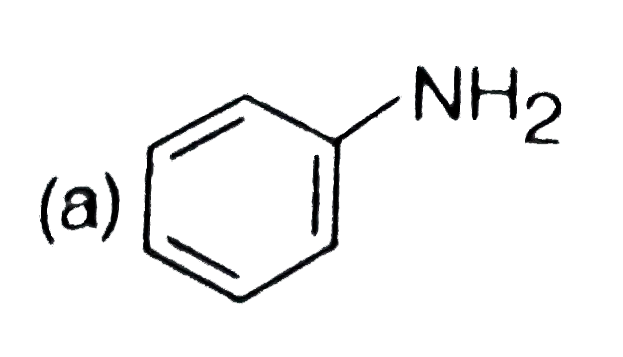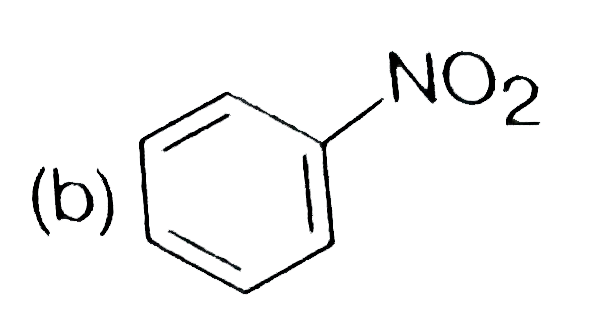An aromatic compound (A) on treatment with aqueous ammonia and heating forms compound (B) which on heating with Br2 and KOH forms a compound (C ) of the molecular formula C6H7N. Write the structures and IUPAC names of compounds (A) . (B) and (C ).
To solve the problem step by step, we will identify the compounds (A), (B), and (C) based on the given reactions and molecular formula.
Step 1: Identify Compound (A)
The problem states that an aromatic compound (A) reacts with aqueous ammonia to form compound (B). Given the context, a suitable aromatic compound that can react with ammonia is benzoic acid.
- Structure of Compound (A):
- Benzoic acid:
C6H5COOH
- IUPAC Name of Compound (A):
- Benzoic acid
Step 2: Identify Compound (B)
When benzoic acid reacts with aqueous ammonia and is heated, it forms benzamide.
- Structure of Compound (B):
- Benzamide:
C6H5CONH2
- IUPAC Name of Compound (B):
- Benzamide
Step 3: Identify Compound (C)
Next, compound (B) (benzamide) is heated with Br2 and KOH. This reaction leads to the formation of aniline.
- Structure of Compound (C):
- Aniline:
C6H5NH2
- IUPAC Name of Compound (C):
- Aniline
Summary of Compounds
- Compound (A): Benzoic acid (C₆H₅COOH)
- Compound (B): Benzamide (C₆H₅CONH₂)
- Compound (C): Aniline (C₆H₅NH₂)
The problem states that an aromatic compound (A) reacts with aqueous ammonia to form compound (B). Given the context, a suitable aromatic compound that can react with ammonia is benzoic acid.
- Benzoic acid:
C6H5COOH
- Benzoic acid
When benzoic acid reacts with aqueous ammonia and is heated, it forms benzamide.
- Benzamide:
C6H5CONH2
- Benzamide
Next, compound (B) (benzamide) is heated with Br2 and KOH. This reaction leads to the formation of aniline.
- Aniline:
C6H5NH2
- Aniline
- Compound (A): Benzoic acid (C₆H₅COOH)
- Compound (B): Benzamide (C₆H₅CONH₂)
- Compound (C): Aniline (C₆H₅NH₂)
Topper's Solved these Questions
- XII BOARDSBOOK - XII BOARD PREVIOUS YEAR PAPER ENGLISHCHAPTER - XII BOARDSEXERCISE - General Instrucations
31 Videos
- XII BOARDSBOOK - XII BOARD PREVIOUS YEAR PAPER ENGLISHCHAPTER - XII BOARDSEXERCISE - Questions
29 Videos
- XII BOARDSBOOK - XII BOARD PREVIOUS YEAR PAPER ENGLISHCHAPTER - XII BOARDSEXERCISE - Outside Delhi : SET-III
13 Videos
- SAMPLE PAPER 2019BOOK - XII BOARD PREVIOUS YEAR PAPER ENGLISHCHAPTER - SAMPLE PAPER 2019EXERCISE - SECTION: D
1 Videos
Similar Questions
An aromatic compound 'A' on treatment with aqueous ammonia and heating forms compound 'B' which on heating with Br2 and KOH forms a compound 'C' of molecular formula C6H7N. Write the structures and IUPAC names of compounds A,B and C.
View SolutionAn aromatic compound 'A' on treatment with aqueous ammonia and heating forms compound 'B' which on heating with Br2 and KOH forms a compound 'C' of molecular formula C6H7N. Write the structures and IUPAC names of compounds A,B and C.
View SolutionAn aromatic compound 'A' on treatment with aqueous ammonia and heating forms compound 'B' which on heating with Br2 and KOH forms a compound 'C' of molecular formula C6H7N. Write the structures and IUPAC names of compounds A,B and C.
View SolutionWhich forms aromatic compound on heating?
View SolutionAn aromatic compound A on heating with Br, and KOH forms a compound B of molecular formula CHN which on reacting with CHCI and alcoholic KOH produces a foul smelling compound C. Write the structures and IUPAC names of compounds A, B and C.
View SolutionAn aromatic compound 'A' having molecular formula C7H6O2 on treating with aqueous ammonia and heating forms compound 'B'. The compound 'B' on reaction with molecular bromine and potassium hydroxide provides compound 'C' having molecular formula C6H7N. The structure of 'A' is
View SolutionA given nitrogen-containing compound A reacts with Sn/HCl followed by HNO2 to give an unstable compund B.B on treatment with phenol forms a beautiful coloured compound C with the molecular formula C12H10N2O The structure of compound A is .
(a)
(b)
(c)
(d)
View SolutionAn organic compound with molecular formula C6H12 upon ozonolysis gives only acetone as the product. The compound is :
View SolutionTwo moles of organic compounds 'A' on treatment with a strong base gives two compounds 'B' and 'C'. Compound 'B' on dehydrogention with Cu gives 'A' while acidification of 'C' yields carboxylic and 'D' with molecular formula of CH2O2. Identify the compound A, B, C, and D.
View SolutionA mixture of two aromatic compounds (A) and (B) separated by dissolving it in chloroform followed by extraction with aqueous KOH solution. The organic layer containing compound (A) when heated with alcoholic solution of KOH produced a compound (C ) (C7H5N) associated with an unpleasant odour . The alkaline aqueous layer on the other hand , when heated with chloroform and then acidified gave a mixture of two isometic compounds (D) and (E ) of molecular formula C7H6O2. Identity the compounds (A), (B ) . (C ) (D), and (E ) and write their structures .
View Solution
